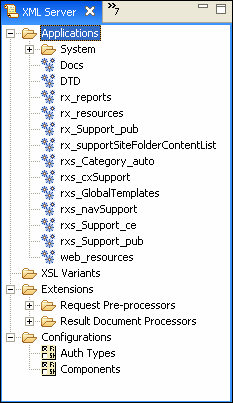XML Server
The XML Server view contains Percussion objects. You will be able to maintain and modify these objects, and even add new objects in most cases.
XML Server view is visible in the default Percussion perspective. To display the XML Server view, select the Window > Show view > Other > XML Server in the Menu bar.

This view contains the following top-level nodes:
- Applications
- XSL Variants
- Extensions
- Configurations
Applications
The Applications folder lists all Percussion XML applications in your system. It contains a System folder and any number of user-defined folders. The System folder contains all system applications. An application is considered a system application if it includes a Type property set to System, or if it does not include a Type property and the application name begins with the string "sys_" or "perc",
The user-defined folders contain non-system applications. You can define a set of user-defined folders to help you classify your applications for easier navigation. However, user applications may appear directly under the Applications node.
Learn more about working with XML Applications.
XSL Variants
XSL Variants are not applicable in Percussion CM1 installations. The XSL Variants folder lists all legacy Variants in the system. This folder lists Content Types with which at least one Variant is associated. Each Content Type contains an Associated Variants folder that includes all of the Variants associated with that Content Type. Each Variant contains a Contained Slots node, which lists references to all of the Slots contained in that Variant.
Extensions
The Extensions folder lists all extensions (generally Java plugins) that apply to XML applications. All extensions are included in one of the following sub-folders:
- Request Pre-processors - Extensions that execute before an application creates its output XML document.
- Result Document Processors - Extensions that execute after an application creates its output XML document.
Within these sub-folders, extensions may be located in sub-folders that identify their functional categories. This node and its contents are read-only.
Configurations
The Configurations node lists configurations that are included for backwards compatibility.
See Also
Adding Extension Parameters
Saving, Starting, and Stopping an Application
Exporting Application XML
Deleting an Application
